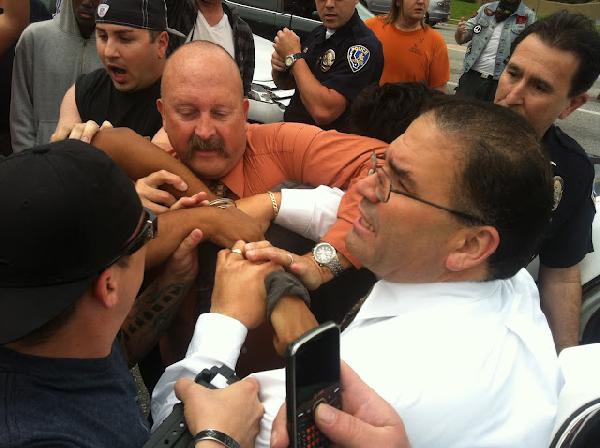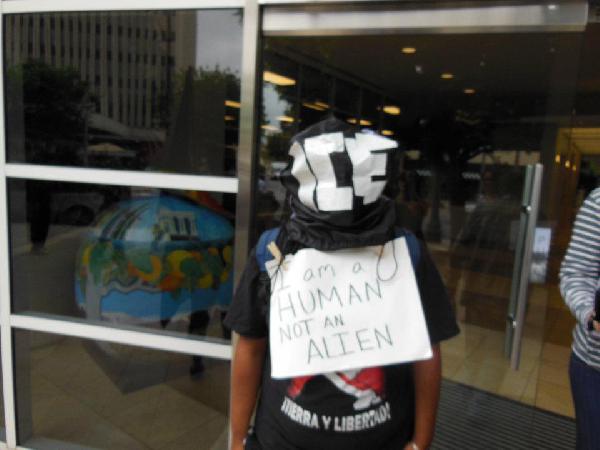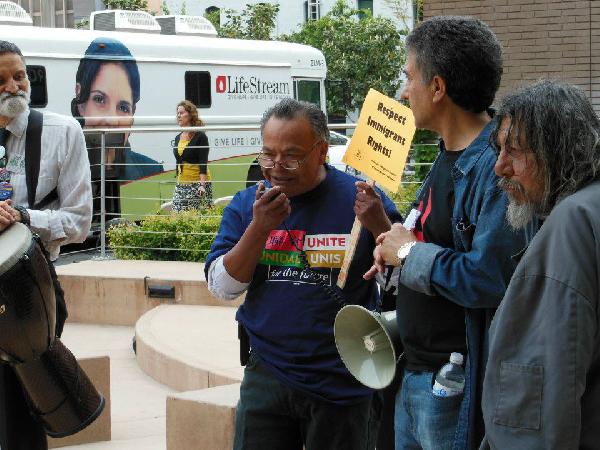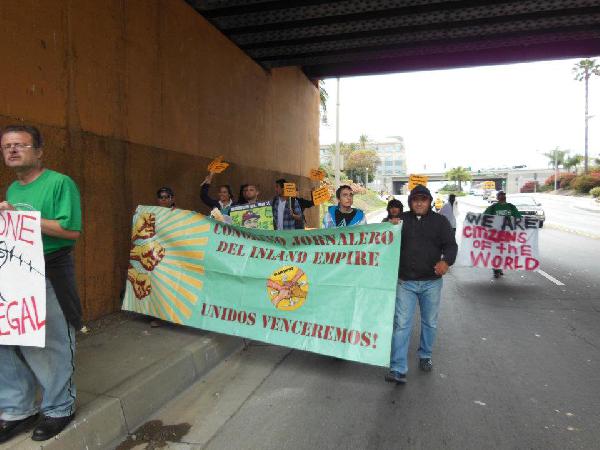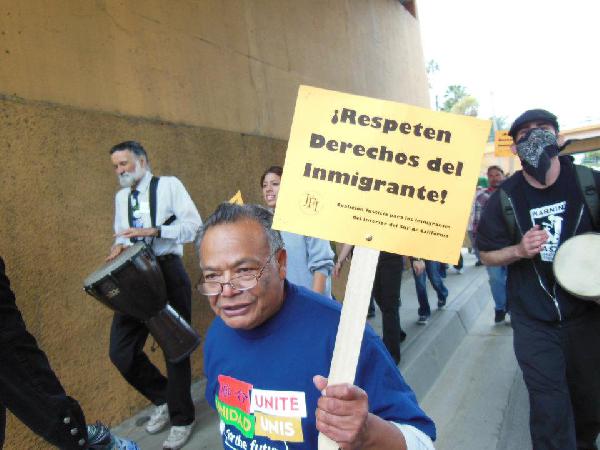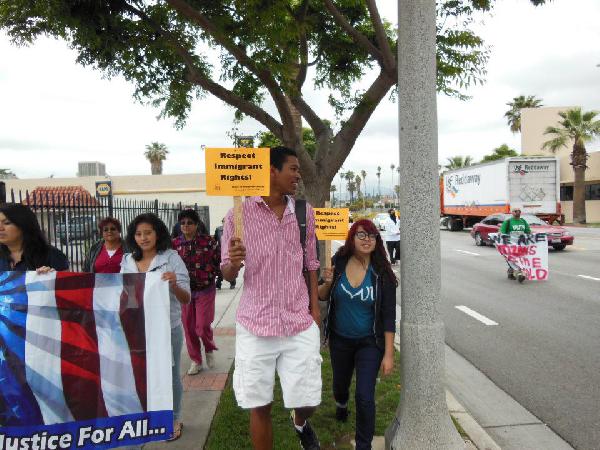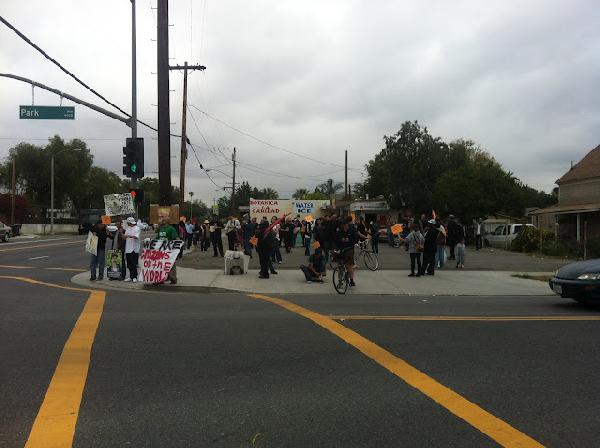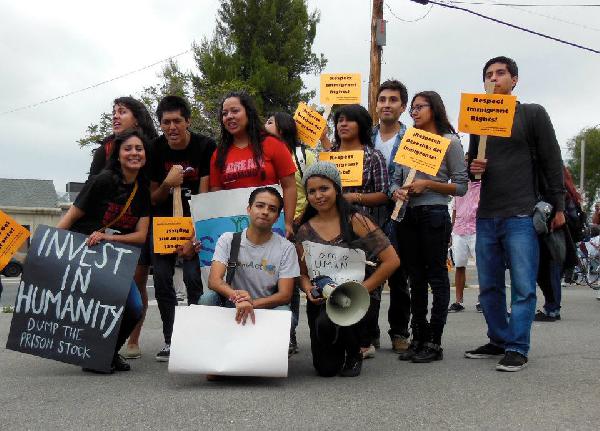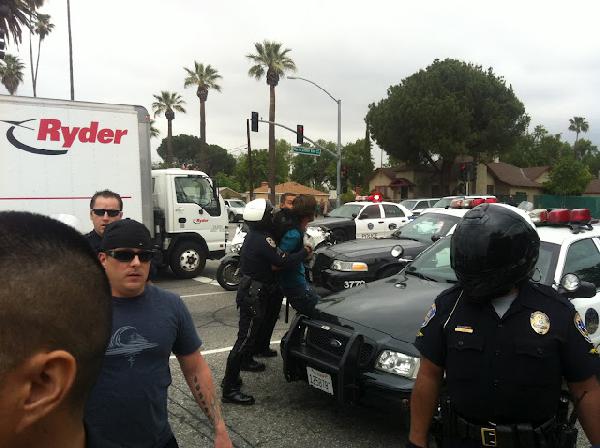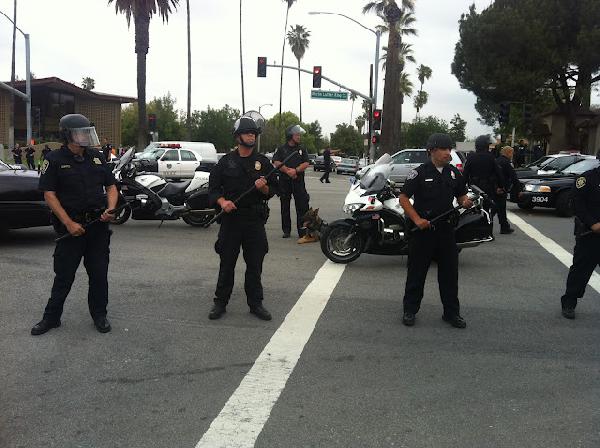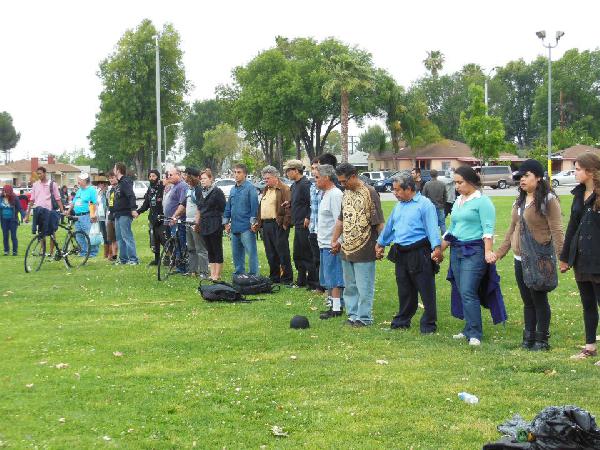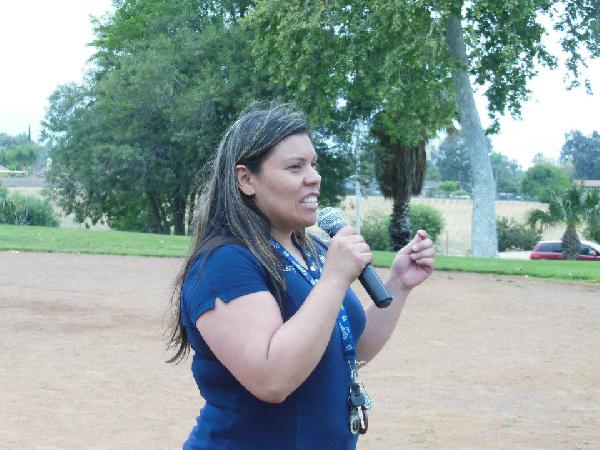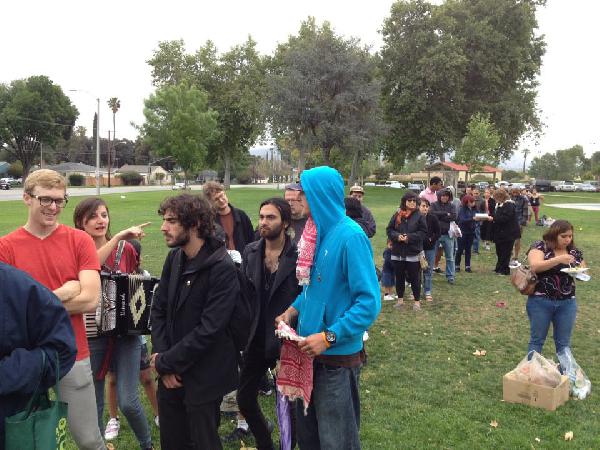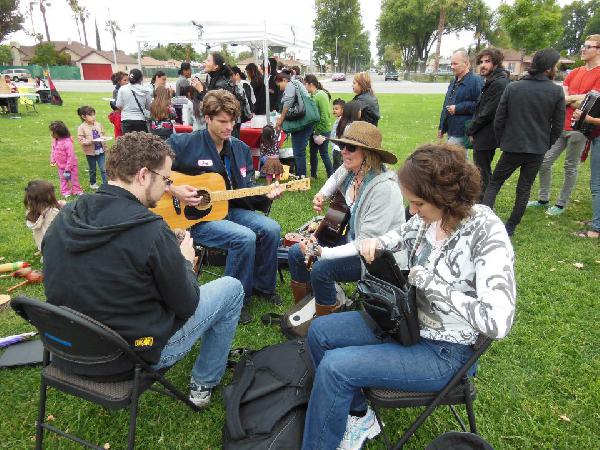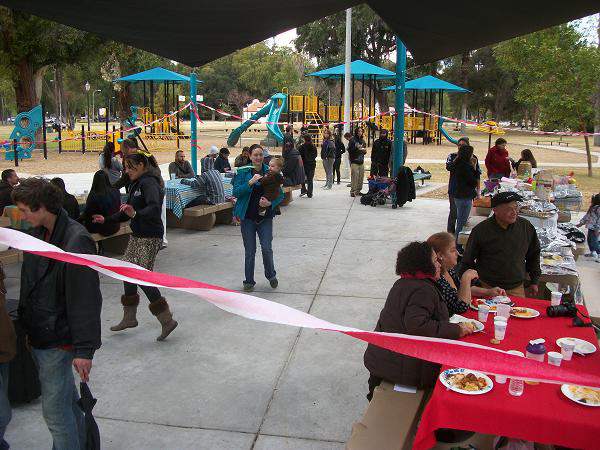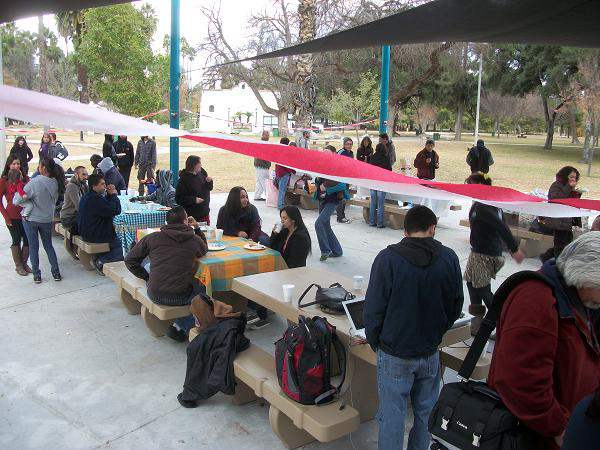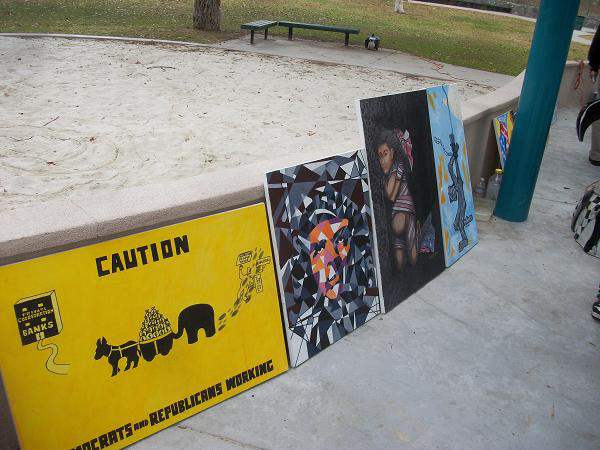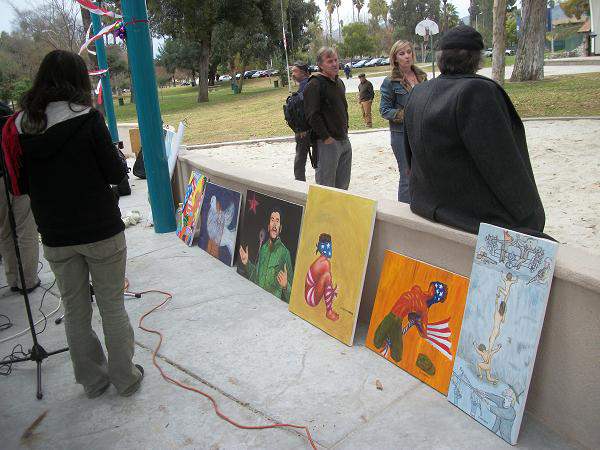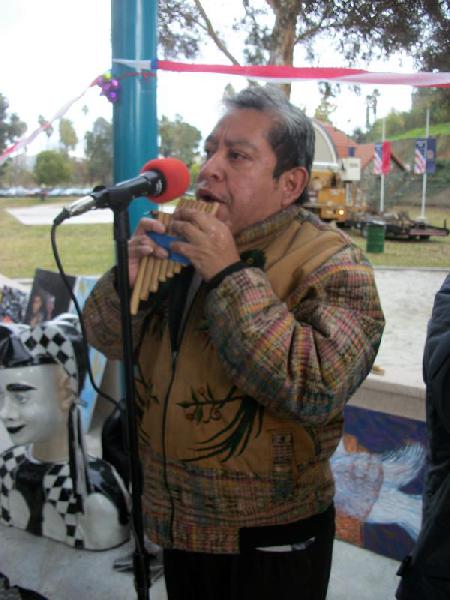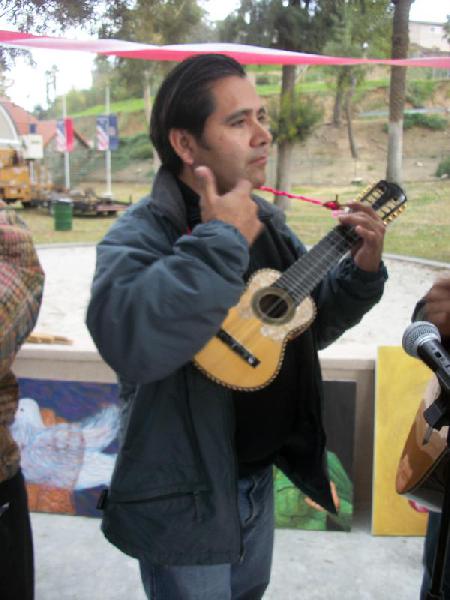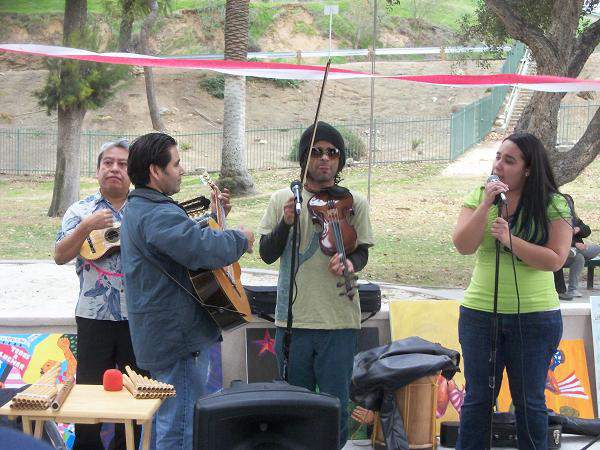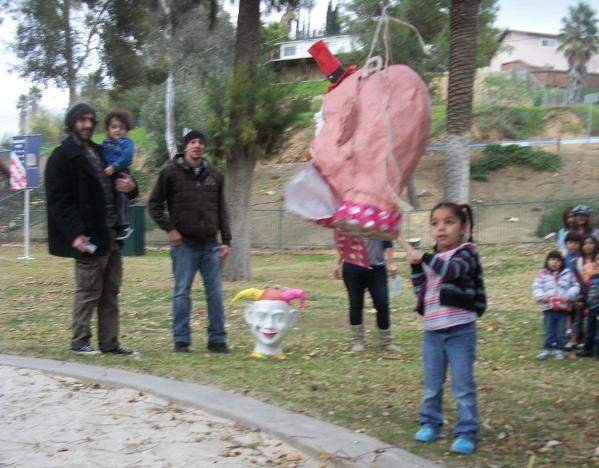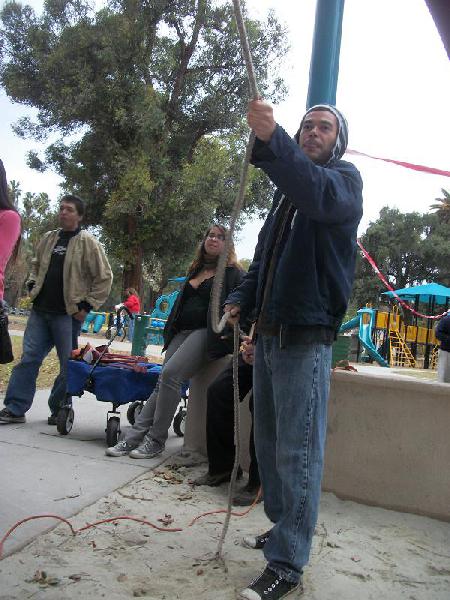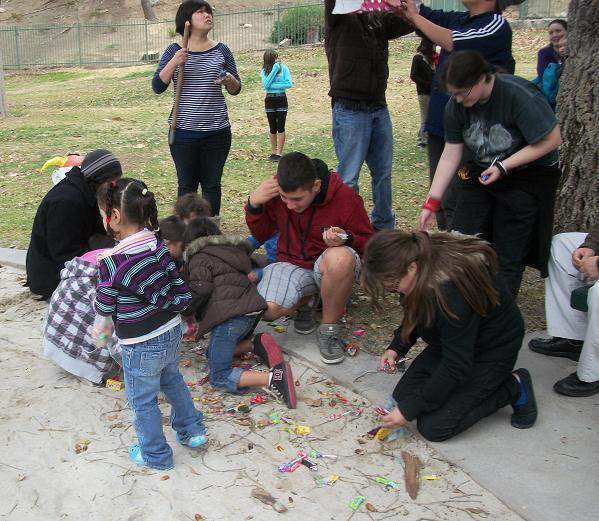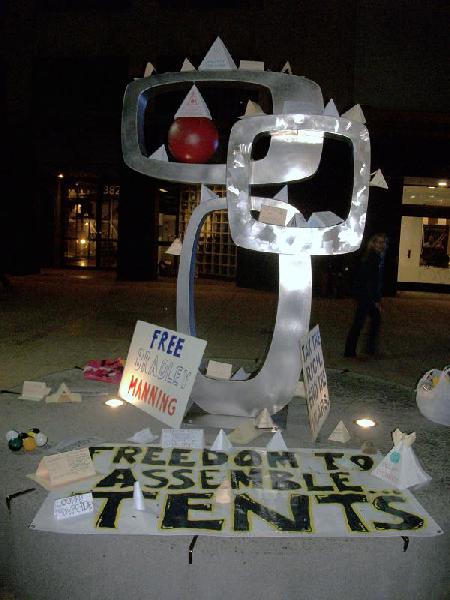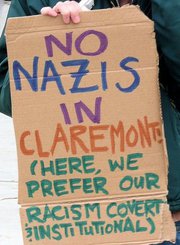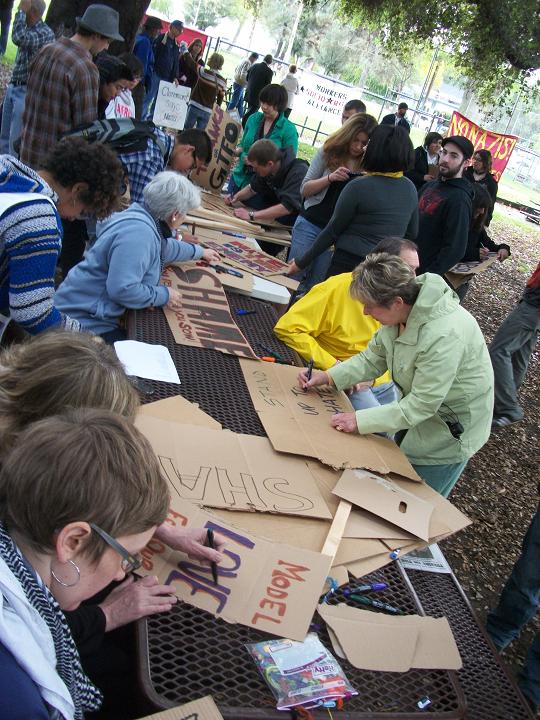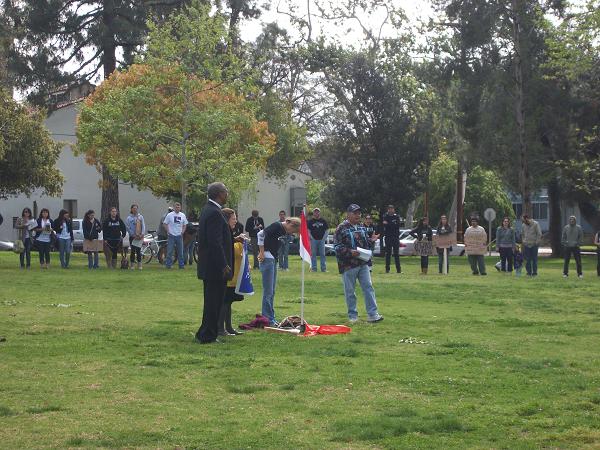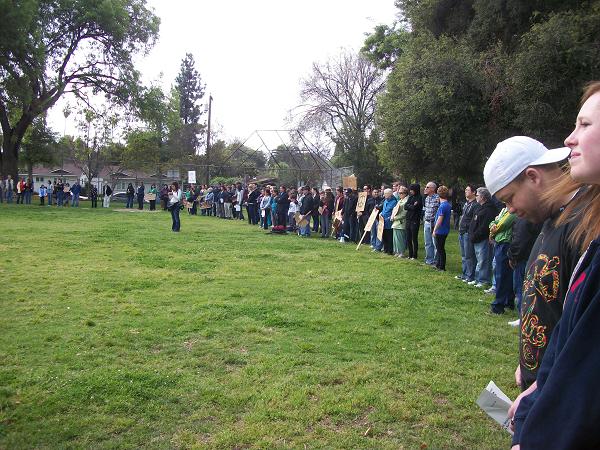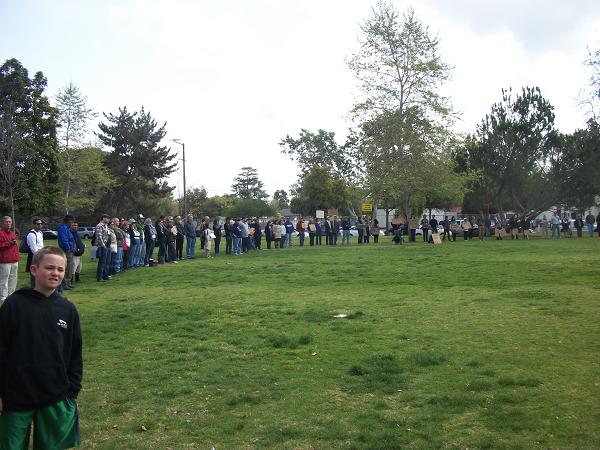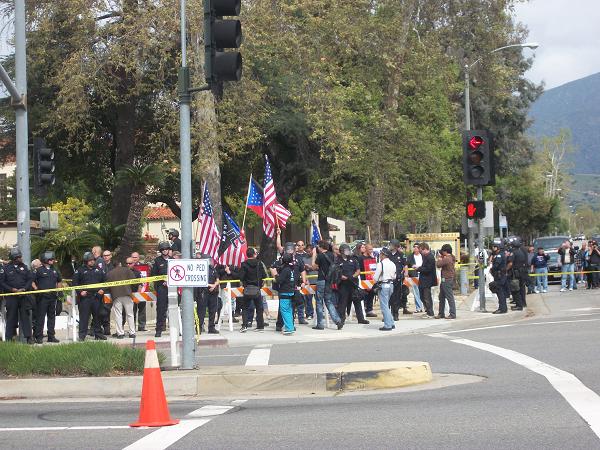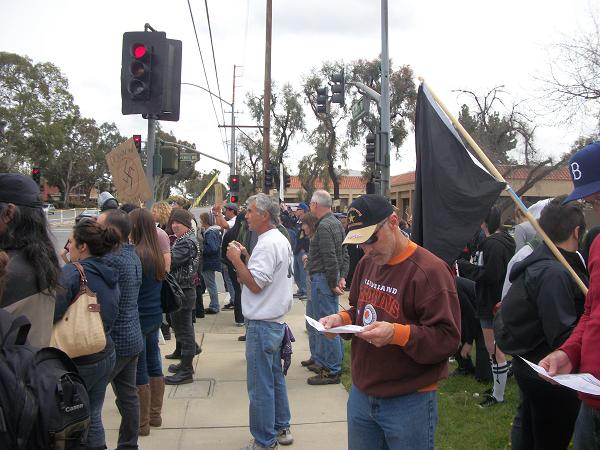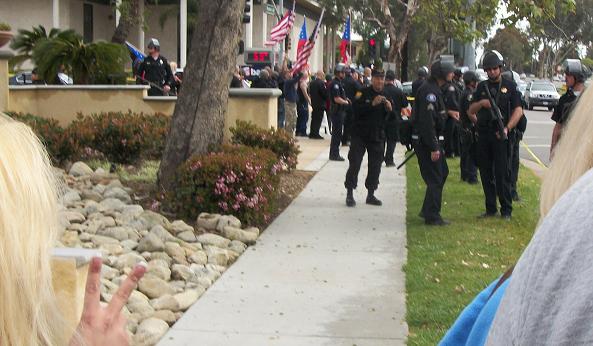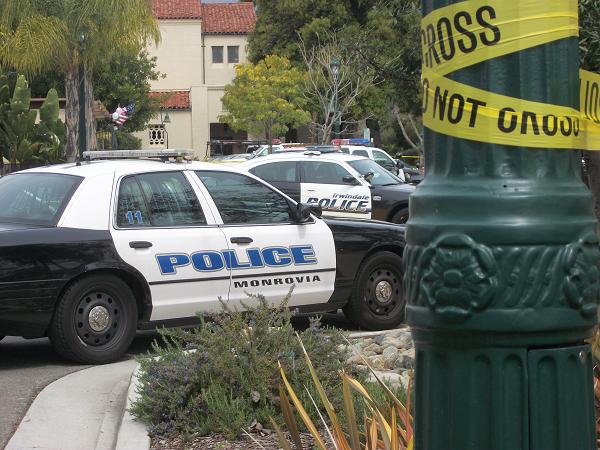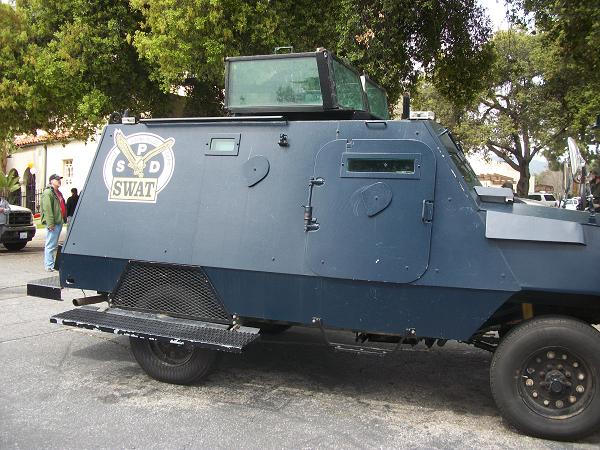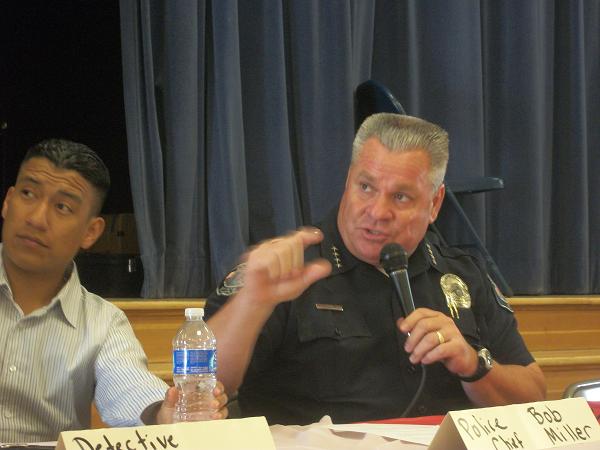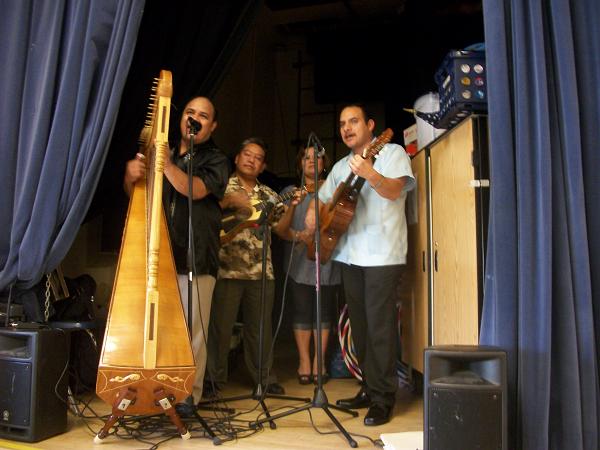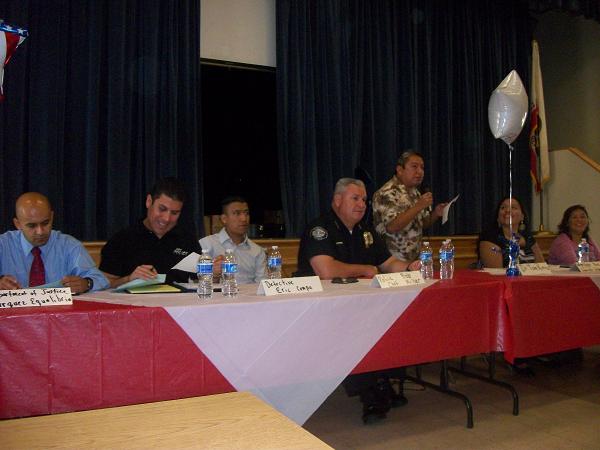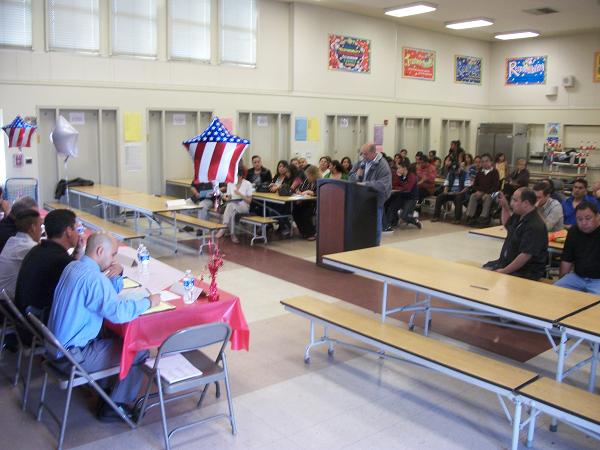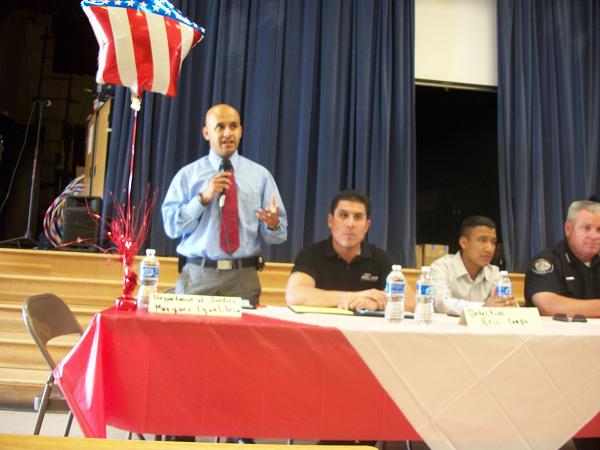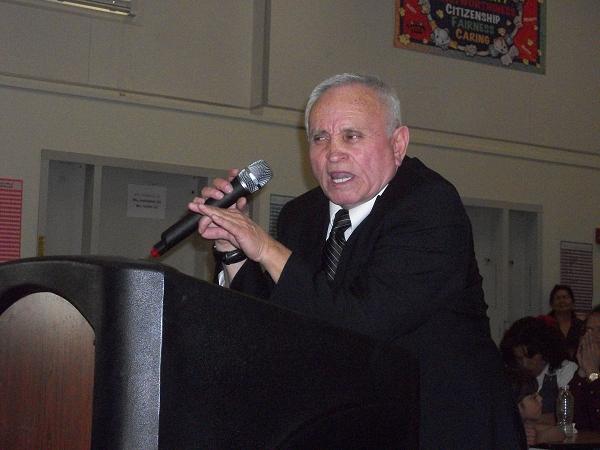Tuesday, May 1, 2012
RIVERSIDE (CA) - Several hundred people participated in a series of actions marking International Worker's Day in Southern California's Inland Empire. The day featured an Occupy bank protest, an immigrant rights march and rally, and a food and clothing giveaway hosted by an autonomous grouping. The day of community empowerment was temporarily disrupted, however, when police violently targeted students and arrested them.
Occupy Riverside planned and hosted the #F29 day of non-violent direct action to shut down the corporations comprising the American Legislative Exchange Council, focusing on distribution centers used by Walmart, as a build-up action for May 1.
Outreach was also done to labor unions, organizing efforts, community groups, and immigrant rights groups. Hundreds of doors were knocked on in the Riverside area, primarily in the downtown and Eastside areas.
Other, less-traditional methods were also used, although it is not clear by whom. Capitalizing on the vast talent pool within Occupy Riverside and the larger Inland Empire community, numerous works of art were produced, distributed, and posted throughout the region. Wheatpasted and painted messages were spotted in Riverside, Corona, Ontario, Pomona, Claremont, and Chino. No particular group has claimed credit.
Another unorthodox method was used on Monday, April 30th. Students at John North High, Arlington High, And Ramona High Schools in Riverside were distributed letters claiming to be from the district superintendent announcing the cancellation of classes. In response, the district made over 100,000 automated phone calls to district households to disavow the letter and demand that students attend school, where standardized testing was scheduled to occur at many campuses. According to reports in the corporate media, the schools are "working on an investigation with Riverside police."1
Occupy Riverside also took the initiative to schedule a week of consciousness-raising events prior to May 1. The "Five days of May" spring training began on April 26, with an education fair held in People's Plaza, the site of the former Occupy Riverside camp. Workshop topics included the history of May Day, 9/11 and its political aftermath, a primer on immigration and immigrant rights, and a discussion on problems in the public education system and the need for unity between students, faculty, and staff to bring about change.
The following day featured a payday protest of Wells Fargo, calling particular attention to the bank's financing of private prison corporations and the impact the industry has on the migrant population. That action featured a march, streetcorner rally, the setting up of a tent, and a "tour" of the bank, in which OR militants entered and chanted "Invest in communities, not in jails!" before being asked to leave. Police responded as soon as the tent was set up in front of the bank (they did not seem to mind a bit while it was on the street corner) and forced its removal. Otherwise, the protest went off without incident.
On Saturday a march was scheduled to promote the Occupy Riverside-initiated May 1 gas boycott in protest of high gas prices and all the other injustices rooted in the petroleum industry, from ecological disasters like the BP oil spill to their influence over US foreign policy and the wars it creates.
Plans changed, however, when Occupy activists learned of an anti-violence rally planned by the Riverside Area Peace and Justice Alliance, and most went to join them. Some, however, spread the word about the gas and driving boycott. Occupy Riverside has found that targetting petroleum companies has been effective means of tapping into popular anger toward high gas prices.
All were small actions in comparison with Tuesday. May Day began with a noon protest of Wells Fargo, which had extra security since early in the morning. About 40 picketers shouted anti-bank slogans, and mic-checked the reasons they were opposed to the banks practices, naming the foreclosure crisis and the financing of for-profit detention centers as our primary grievances.
The ATMs were declared "out of order" and the bank was declared "shut down" for the day. We then entered the building lobby, which caused the security to enter the bank and lock the doors.
Customers were still allowed to enter, but only one at a time, and were locked in once they entered.
Occupy Riverside posted notices of closure on the banks doors and then ceremoniously exited, chanting "No private prisons!"
We then marched a block south to Riverside City Hall, where we joined the pre-march rally hosted by the Justice for Immigrants Coalition of Inland Southern California, a broad-based coalition of faith-based, labor, student, and community groups and activists. Speakers included people from the Inland Valley Friends, Riverside's homeless community, Occupy Hemet, as well as workers from the Pomona College dining hall and Martin Berrospe, a Rancho Cucamonga day laborer recently racially profiled and detained during ICE's "Operation Cross-Check," which purported to target "criminal aliens" for deportation in the largest ICE operation in US history. Berrospe, however, has no record and was stopped without any reasonable suspicion that he was undocumented. He was detained for 36 days but refused to waive his rights and was freed after a community campaign to raise his bond. He will be facing deportation proceedings this summer, but was on hand to express his gratitude and words of encouragement.
After a few speeches to energize the crowd, the hundred-plus marched through People's Plaza and down University, taking both the sidewalk and the street.
Members of the Inland Empire Immigrant Youth Coalition led chants of "Undocumented and unafraid!" and many other pro-migrant slogans.
At Park Street, we turned to pass the historic Our Lady of Guadalupe Shrine, an important site for Eastside Riversiders. Faithful there distributed water to the thirsty marchers and joined the parade.
Upon arriving at the corner of 14th and Park, marchers occupied the intersection, blocking traffic for several minutes while waiting for the contingent of students from Riverside Community College to join us.
After some delay, march organizers continued the march to Bordwell Park, sensing the impatience of the crowd and certain of the safe arrival of their RCC comrades. Shortly after leaving the intersection, police began to follow the march.
Upon arriving at Bordwell Park, picnic tables full of free groceries awaited us, as did piles of clothes, furniture, and household items gathered by volunteers from Riverside's Really Really Free Market. The Occupy Riverside and Occupy UCR library was revived and many boxes of books, most of them political in nature, were distributed.
Sound systems were set up, and protesters began to settle in for the rally when screams came from the street. The crowd rushed to the intersection of Martin Luther King and Kansas to observe the police brutality occurring there. The RCC contingent had finally caught up with the main march but was attacked just prior to its arrival at the park. It is unclear why.
Witnesses reported that while some students marched on the sidewalk, those arriving on bicycle were legally riding on the street. March security guided them, but was clipped by two vehicles. In plain view of the "escorting" officer, these two vehicles came dangerously close to the march security, endangering their safety. The police did nothing to intervene in the situation.
Subsequently, according to witnesses, an officer in a vehicle ordered one of the cyclists onto the sidewalk. When the cyclist, an RCC student, questioned the order due to its illegality, the car cut off the path of the cyclist and the officer attempted to pull the student from his bicycle. The officer then kicked him and hit him with his baton.
It was at this point that the cry for witnesses and cameras went up and people rushed to the corner. Within seconds, numerous police vehicles, both marked an unmarked, were on the scene. The officers scuffled with protesters, bringing out riot weapons such as rubber bullet guns and police dogs. They arrested the initial cyclist and then another young man, a UCR student, slamming him violently to the ground. According to reports in the Spanish-language media, he was also beaten while handcuffed on the ground.2
After the second arrest, the crowd returned calmly and peacefully to the park depite the growing number of armed and armored officers in the street. Once the officials realized that we were not going to allow ourselves to be provoked into using any kind of violence against them, they withdrew their forces, leaving only a few cars around the perimeter of the park within sight of the convergence.
Since the crowd's nerves remained on edge, Julio Marroquin, a community activist and the founder of the Inland Empire Latino Forum within Occupy Riverside, led an ecumenical prayer denouncing the police violence and urging peace. Once we were a bit calmer, we began hearing speakers on a number of topics. Luz Gallegos of TODEC informed us about the struggle in Southern Riverside County, and Jose Calderon, professor emeritus at Pitzer College gave a brief historical retrospective in honor of Lucy Gonzales Parsons and her partner Albert, who was assassinated by the state in the wake of the 1886 Haymarket Affair in Chicago.
Over 200 meals were served courtesy of the People's Kitchen and community members, and meals included vegan options. A group of DREAMers joined a pickup soccer game with some Riverside occupiers, and musicians formed a circle and found expression. Others held discussion groups to digest the police repression, and much information was shared at the welcome table.
A critical mass bike ride, originally scheduled for seven p.m. at the end of the convergence, was reorganized. Rather than waiting, the cyclists decided to ride to the Robert Presley Detention Center to support the arrestees and to gather information.
While several activists and community members were quite upset about the violence and the state's attempts to shatter the unity we had created between multiple factions as well as the neighboring community, others sought to emphasize the triumphs of the movement that were embodied in the day and its events.
Activists vowed to pursue all avenues towards justice for those who were wrongly detained, as well as to continue organizing throughout the year to build community and power for oppressed people.
1. Straehley, Dana. "RIVERSIDE: Schools asks police to investigate fake May Day letter." Press-Enterprise, May 2, 2012. http://www.pe.com/local-news/riverside-county/riverside/riverside-headlines-index/20120502-riverside-schools-asks-police-to-investigate-fake-may-day-letter.ece accessed May 3, 2012.
2. Cano, Alejandro. "RIVERSIDE: Policía interviene en manifestación," La Prensa, May 1, 2012. http://www.laprensaenlinea.com/noticias/noticias-historias/20120501-riverside-policia-interviene-en-manifestacion.ece?ssimg=557859#ssStory557860 accessed May 3, 2012.
